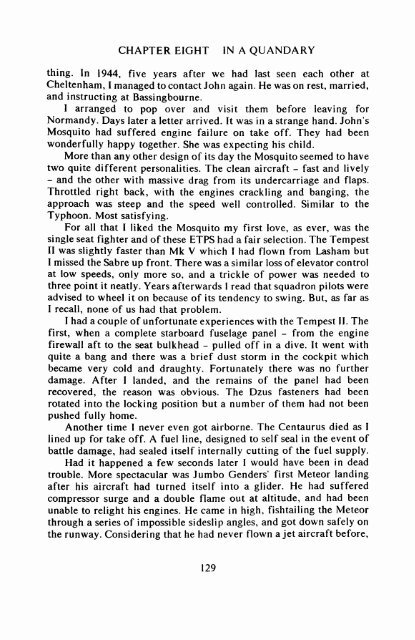COMBAT AND COMPETITION.pdf - Lakes Gliding Club
COMBAT AND COMPETITION.pdf - Lakes Gliding Club
COMBAT AND COMPETITION.pdf - Lakes Gliding Club
You also want an ePaper? Increase the reach of your titles
YUMPU automatically turns print PDFs into web optimized ePapers that Google loves.
CHAPTER EIGHT IN A QU<strong>AND</strong>ARY<br />
thing. In 1944, five years after we had last seen each other at<br />
Cheltenham, I managed to contact John again. He was on rest, married,<br />
and instructing at Bassingbourne.<br />
I arranged to pop over and visit them before leaving for<br />
Normandy. Days later a letter arrived. It was in a strange hand. John's<br />
Mosquito had suffered engine failure on take off. They had been<br />
wonderfully happy together. She was expecting his child.<br />
More than any other design of its day the Mosquito seemed to have<br />
two quite different personalities. The clean aircraft - fast and lively<br />
- and the other with massive drag from its undercarriage and flaps.<br />
Throttled right back, with the engines crackling and banging, the<br />
approach was steep and the speed well controlled. Similar to the<br />
Typhoon. Most satisfying.<br />
For all that I liked the Mosquito my first love, as ever, was the<br />
single seat fighter and of these ETPS had a fair selection. The Tempest<br />
II was slightly faster than Mk V which I had flown from Lasham but<br />
I missed the Sabre up front. There was a similar loss of elevator control<br />
at low speeds, only more so, and a trickle of power was needed to<br />
three point it neatly. Years afterwards I read that squadron pilots were<br />
advised to wheel it on because of its tendency to swing. But, as far as<br />
I recall, none of us had that problem.<br />
I had a couple of unfortunate experiences with the Tempest II. The<br />
first, when a complete starboard fuselage panel - from the engine<br />
firewall aft to the seat bulkhead - pulled off in a dive. It went with<br />
quite a bang and there was a brief dust storm in the cockpit which<br />
became very cold and draughty. Fortunately there was no further<br />
damage. After I landed, and the remains of the panel had been<br />
recovered, the reason was obvious. The Dzus fasteners had been<br />
rotated into the locking position but a number of them had not been<br />
pushed fully home.<br />
Another time I never even got airborne. The Centaurus died as I<br />
lined up for take off. A fuel line, designed to self seal in the event of<br />
battle damage, had sealed itself internally cutting of the fuel supply.<br />
Had it happened a few seconds later I would have been in dead<br />
trouble. More spectacular was Jumbo Genders' first Meteor landing<br />
after his aircraft had turned itself into a glider. He had suffered<br />
compressor surge and a double flame out at altitude, and had been<br />
unable to relight his engines. He came in high, fishtailing the Meteor<br />
through a series of impossible sideslip angles, and got down safely on<br />
the runway. Considering that he had never flown a jet aircraft before,<br />
129

















